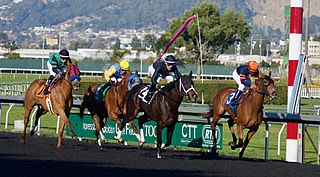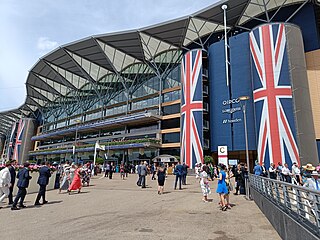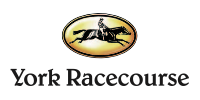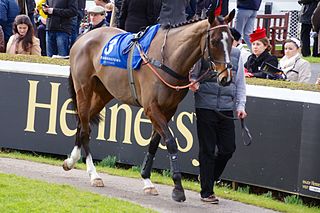
Horse racing is an equestrian performance sport, typically involving two or more horses ridden by jockeys over a set distance for competition. It is one of the most ancient of all sports, as its basic premise – to identify which of two or more horses is the fastest over a set course or distance – has been mostly unchanged since at least classical antiquity.

Horse racing is the second largest spectator sport in Great Britain, and one of the longest established, with a history dating back many centuries. According to a report by the British Horseracing Authority it generates £3.39 billion total direct and indirect expenditure in the British economy, of which £1.05 Billion is from core racing industry expenditure and the major horse racing events such as Royal Ascot and Cheltenham Festival are important dates in the British and international sporting and society calendar.
In horse racing in Great Britain, France and Republic of Ireland, National Hunt racing requires horses to jump fences and ditches. National Hunt racing in the UK is informally known as "jumps" and is divided into two major distinct branches: hurdles and steeplechases. Alongside these there are "bumpers", which are National Hunt flat races. In a hurdles race, the horses jump over obstacles called hurdles; in a steeplechase the horses jump over a variety of obstacles that can include plain fences, water jump or an open ditch. In the UK, the biggest National Hunt events of the year are generally considered to be the Grand National and the Cheltenham Gold Cup.

Ascot Racecourse is a dual-purpose British racecourse, located in Ascot, Berkshire, England, about 25 miles west of London. Ascot is used for thoroughbred horse racing, and it hosts 13 of Britain's 36 annual Flat Group 1 horse races and three Grade 1 Jumps races.

The Cheltenham Gold Cup is a Grade 1 National Hunt horse race run on the New Course at Cheltenham Racecourse in England, over a distance of about 3 miles 2½ furlongs, and during its running there are 22 fences to be jumped. The race takes place each year during the Cheltenham Festival in March.

York Racecourse is a horse racing venue in York, North Yorkshire, England. It is the third biggest racecourse in Britain in terms of total prize money offered, and second behind Ascot in prize money offered per meeting. It attracts around 350,000 racegoers per year and stages three of the UK's 36 annual Group 1 races – the Juddmonte International Stakes, the Nunthorpe Stakes and the Yorkshire Oaks.

The Cheltenham Festival is a horse racing-based meeting in the National Hunt racing calendar in the United Kingdom, with race prize money second only to the Grand National. The four-day festival takes place annually in March at Cheltenham Racecourse in Cheltenham, Gloucestershire. It usually coincides with Saint Patrick's Day and is particularly popular with Irish visitors.

Best Mate was an Irish-bred, English-trained racehorse and three-time winner of the Cheltenham Gold Cup. He was a popular horse, and his sudden death while racing made front-page news.

Cheltenham Racecourse at Prestbury Park, near Cheltenham, Gloucestershire, England, hosts National Hunt horse racing. Racing at Cheltenham took place in 1815, but comprised only minor flat races on Nottingham Hill. The first racing on Cleeve Hill was on Tuesday 25 August 1818 when the opening race was won by Miss Tidmarsh, owned by Mr E Jones. It was a year later when the results were printed in the Racing Calendar when a programme of flat racing was watched by the Duke of Gloucester who donated 100 Guineas to the prize fund. By 1831 races were being staged at Prestbury, although not on the present day course. In 1834 the Grand Annual Steeplechase was run for the first time. In 1839 Lottery won the Grand Annual having previously won the first Aintree Grand National. In 1840 the meeting transferred to Andoversford for a brief period, only to return to Prestbury in 1847. 1902 was a notable year in that racing moved to the present course at Prestbury Park. The new stands were completed in 1914 and the present day Festival races, as we know them, began to take shape. The Cheltenham Gold Cup, over 3 ¼ miles, was run for the first time in 1924, with the Champion Hurdle following in 1927.

Desert Orchid, known as Dessie, was an English racehorse. The grey achieved a revered and esteemed status within National Hunt racing, where he was much loved by supporters for his front-running attacking style, iron will and extreme versatility. He was rated the fifth-best National Hunt horse of all time by Timeform. During his racing career he was partnered by five different jump jockeys: Colin Brown, Richard Linley, Simon Sherwood, Graham Bradley and Richard Dunwoody.

Ayr Racecourse at Whitletts Road, Ayr, Scotland, was opened in 1907. There are courses for flat and for National Hunt racing.
Brighton Racecourse is an English horse racing venue located a mile to the northeast of the centre of Brighton, Sussex, owned by the Arena Racing Company.

Huntingdon Racecourse is a thoroughbred horse racing venue located in Brampton near Huntingdon, Cambridgeshire, England. It is located on a Site of Special Scientific Interest of the original Brampton Racecourse.

Kelso Racecourse is a thoroughbred horse racing venue located in Kelso, Scotland. It is frequently described as "Britain's Friendliest Racecourse". It was voted the Best Small Course in Scotland and the North of England in 2007, 2012 and 2014 by the Racegoers Club. In addition to staging Scotland's most valuable hurdle race, the Morebattle Hurdle, Kelso stages a comparatively high number of Class 1, 2 & 3 races over jumps.

Epsom Downs is a Grade 1 racecourse in a hilly area near Epsom in Surrey, England which is used for thoroughbred horse racing. The "Downs" referred to in the name are part of the North Downs.
The Haldon Gold Cup is a Grade 2 National Hunt steeplechase in Great Britain which is open to horses aged four years or older. It is run at Exeter over a distance of about 2 miles and 1½ furlongs, and during its running there are twelve fences to be jumped. The race is scheduled to take place each year in late October or early November.
Jim Culloty is a racehorse trainer and retired professional National Hunt jockey who won both the Cheltenham Gold Cup and Grand National in the same season. Culloty and Mick Fitzgerald both worked for Jackie Retter, who trained at Whitstone, near Exeter, before they went their separate ways, Culloty to work for Henrietta Knight while Fitzgerald went with Nicky Henderson.
Horse racing in Wales has a long tradition dating back to the 18th century. Wales has held flat racing, National Hunt and harness racing, and presently has three racecourses, at Chepstow, Bangor-on-Dee and Ffos Las. The Welsh Grand National is held annually at Chepstow between Christmas and New Year and is the highlight of the Welsh racing calendar.

Lord Windermere is an Irish Thoroughbred racehorse who competes in National Hunt racing. He is a successful steeplechaser, winning the RSA Chase in 2013 and the Cheltenham Gold Cup in 2014.

Buckfastleigh Racecourse was a British horse racing venue.



















